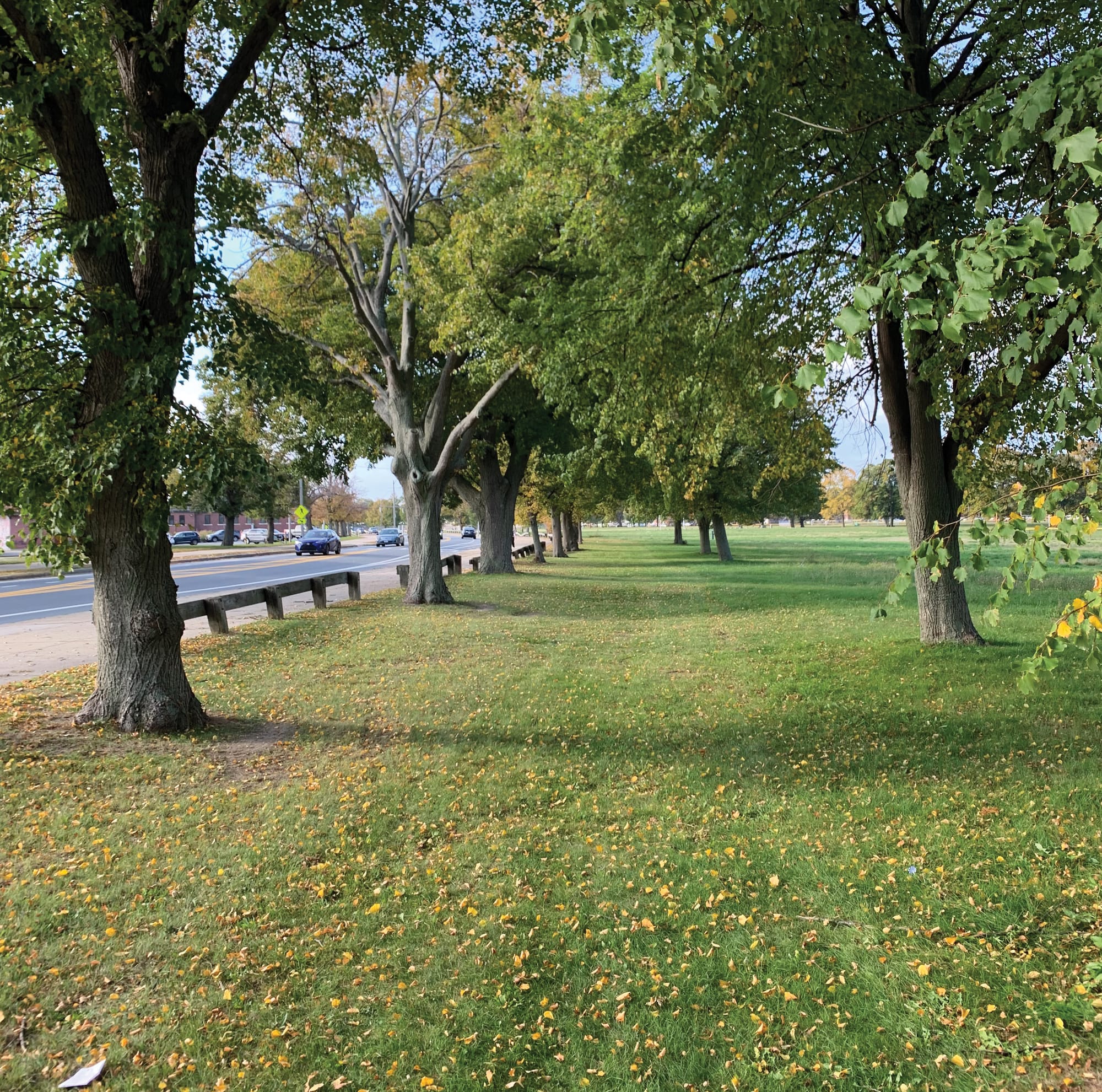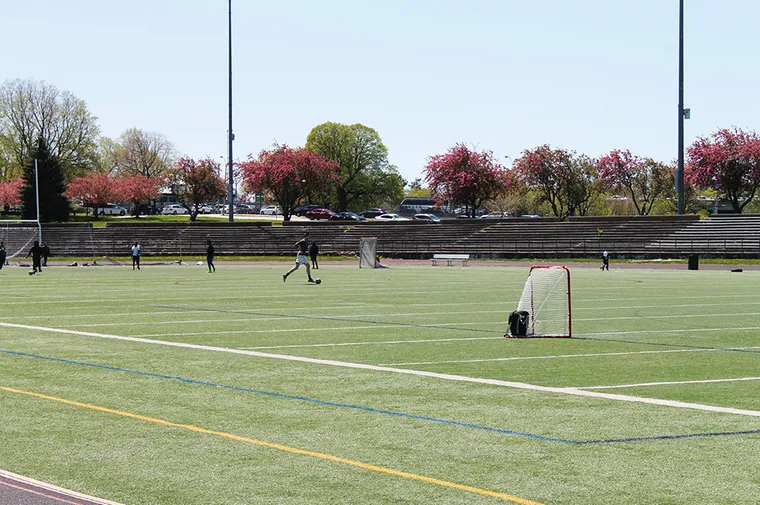Building cool parks to beat the urban, heat-island effect
By Rupsa Roy, Julie Eaton Ernst, and Indrani Ghosh
Parks and open space function as critical infrastructure for public health as well as for mitigating and adapting to climate change. This is especially evident in island environments, where there is limited vegetation, paved surfaces, and dense development. These compounding factors result in higher temperatures when compared to those in rural surroundings—a phenomenon known as the “urban heat-island” (UHI) effect—along with increased stormwater-runoff volumes, velocities, and pollutants that exacerbate urban flood events.
Vegetated parks and open space are intrinsically cooler than their developed surroundings in cities; trees and natural land cover help mitigate the UHI effect by providing shade and evaporative cooling. They also reduce stormwater-runoff problems by absorbing and filtering rainwater. Parks can be intentionally planned and designed to reduce UHI risks, which is critical with rising temperatures locally and globally. The resilient re-design of Moakley Park is pioneering this process through iterative UHI modeling.
Moakley Park is a 64-acre, recreational park located along Dorchester Bay in South Boston, Mass. The existing park includes several natural-turf baseball, softball, and Little League fields; multi-use fields; basketball, tennis, and street-hockey courts; a concrete football stadium with a synthetic-turf field and track; two field houses; and two playgrounds. The park is surrounded by mapped, environmental justice block groups, including two Boston Housing Authority projects that house over 1,700 low-income families (see sidebar). Communities of color and low-income communities have borne the biggest environmental injustices, including the impacts of climate change. The area within walking distance of the park is expected to double in population in the next decade, based on planned development.
The city of Boston’s planning efforts, known as Climate Ready Boston, has designated Moakley Park as a significant, neighborhood, coastal-flood pathway in the future due to sea-level rise. The 2018 Vision Plan and subsequent schematic design project include integrating a coastal-flood barrier into the landscape with trees and green infrastructure. Given its size and location, Moakley Park is already much cooler than its densely developed surroundings. However, its role in reducing the UHI effect and providing cooling benefits for the surrounding vulnerable community is critical with the number of days over 90°F expected to triple over the next 30 years.
Combatting UHI
The UHI effect at Moakley Park and similar urban environments can be reduced through landscape-design decisions.
- Keep it light. Recreational courts, playgrounds, walkways, retaining walls, patios, and parking lots are features that are designed using “hardscape” materials. The lighter the material color, the more reflective it is to heat. Darker-color materials, such as asphalt and brick, absorb and retain heat.
- Replicate natural processes. Groundcover in parks varies and may include natural or synthetic turf, gravel or paved walkways, and native vegetation/plantings. Plants and water-absorbent surfaces enable evapotranspiration, which cools the air by using the heat from the air to evaporate water[1]. Vegetated and/or porous surfaces also reduce flooding and erosion, and improve water quality when compared to impervious surfaces like asphalt and concrete.
- Create urban forests. Trees have been recognized as effective at mitigating the UHI effect in numerous studies. The trees provide shade that reduces the amount of solar radiation absorbed by the ground and buildings, and the trees also release water vapor through transpiration, which cools the air. Trees also offer many other benefits, such as improving air quality, reducing stormwater runoff, enhancing quality of life, and providing habitat for wildlife.

Integrating these best practices is not as straightforward as “do it in all locations” when it comes to planning and designing urban parks. Neighborhoods like South Boston have a high demand for public open space, and urban parks departments strive to maximize programming to meet the community’s active and passive recreational needs. Take for example the selection of a material color for constructed features. White surfaces are highly reflective and reduce UHI effect but increase glare, which may impact safety during recreational activities. Similarly, trees cast shadows, which may impact visibility on fields or courts, if sited too closely. It’s the balance of informing what a combination of strategies has the most impact for any project site, given its programming needs.
UHI modeling can identify areas within parks that are most susceptible to high temperatures and develop strategies to mitigate those effects. Modeling can identify areas with high heat absorption, where increasing the amount of shade, through planting trees or installing shade structures, may reduce temperatures. The effectiveness of different materials proposed for paths, seating areas, and other park features in reducing heat absorption and retention can also be assessed. Modeling the impacts of these designs through an iterative process helps landscape architects make informed decisions in creating a functional and sustainable space for the community.
Impactful Changes
As part of the schematic design of Moakley Park, the following proposed changes were modeled and compared to those existing park conditions:
- Proposed change in surfaces: UHI modeling showed that modifying the surface of 30 acres within the park could increase the UHI impact. However, replacing 70 percent of the proposed materials with lighter-colored and reflective materials may reduce the temperature up to 4°F in some areas, compared to existing conditions.
- Proposed change in tree canopy: Adding tree canopy was an integral part of the park’s redesign. UHI modeling showed that, when mature, the canopy can result in a cooling of up to 3.5°F when compared to existing conditions. Even if some of the trees don’t reach maturity, the increase in overall canopy will still benefit the park.
- Proposed composite changes: Three different combinations of proposed changes in surfaces and tree canopy were modeled to identify optimal cooling benefits. Most of the park (center and south) is estimated to experience up to 4°F of cooling under the proposed design. However, the northwest corner of the park has modeled similar or slightly higher temperatures than existing conditions, due to maintenance constraints that required impervious surfaces related to vehicular traffic and recreational features.
- Proposed changes informed from iterative UHI modeling: Knowing the areas where UHI effects are not lowered under the proposed redesign of the park also informed design decisions. Following findings from the first iteration, lighter-colored roofs and shade structures were suggested, where they previously had not been planned. Landscape architects can also integrate additional strategies such as increased signage related to heat safety, and targeting areas for misting stations, water play, and/or water fountains to reduce heat-related illnesses.
Moakley Park’s schematic design was enhanced through iterative UHI modeling, including effectively incorporating lighter-colored materials and adjusting tree siting to provide optimal shade conditions that did not interfere with recreational needs. Additional shade structures were proposed to provide increased comfort to park visitors. Combined with collaboration between landscape architects, engineers, park staff, and the public, the UHI model informed the design of a more sustainable, equitable, and healthy urban environment. Given the global warming trend in temperatures, more urban parks will benefit from the knowledge gained by integrating UHI modeling into the planning and design processes.
Rupsa Roy, Ph.D., is a Project Scientist at Weston & Sampson in Reading, Mass. Reach her at roy.rupsa@wseinc.com.
Julie Eaton Ernst, PE, is a Team Leader and Lead Resiliency Engineer at Weston & Sampson in Reading, Mass. Reach her at eatonernst.julie@wseinc.com.
Indrani Ghosh, Ph.D., is a Senior Technical Leader at Weston & Sampson in Boston, Mass. Reach her at ghosh.indrani@wseinc.com.
What Is An Environmental Justice Population?
In Massachusetts, an environmental justice population is a neighborhood where one or more of the following criteria are true:
- The annual, median, household income is 65 percent or less of the statewide annual, median household income.
- Minorities make up 40 percent or more of the population.
- 25 percent or more of households identify as speaking English less than “very well.”
- Minorities make up 25 percent or more of the population, and the annual, median, household income of the municipality in which the neighborhood is located does not exceed 150 percent of the statewide annual, median, household income.
The Executive Office of Energy and Environmental Affairs (EEA) uses data from the 2019 American Community Survey to identify environmental justice population areas in Massachusetts. Policy makers and state agencies can then use this information to communicate more effectively with communities affected by their work.
(Source: Mass.gov)
[1] https://www.epa.gov/sites/default/files/2017-05/documents/reducing_urban_heat_islands_ch_2.pdf

